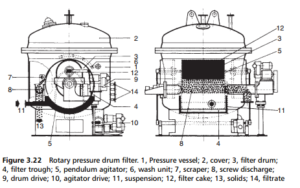0
-
An empty cart
You have no item in your shopping cart
envato-wordpress-toolkit domain was triggered too early. This is usually an indicator for some code in the plugin or theme running too early. Translations should be loaded at the init action or later. Please see Debugging in WordPress for more information. (This message was added in version 6.7.0.) in /var/www/wp-includes/functions.php on line 6121g5plus-darna domain was triggered too early. This is usually an indicator for some code in the plugin or theme running too early. Translations should be loaded at the init action or later. Please see Debugging in WordPress for more information. (This message was added in version 6.7.0.) in /var/www/wp-includes/functions.php on line 6121The rotary pressure drum filter is basically a rotary drum filter enclosed in a large pressure shell, with suitable means for getting the feed suspension and any wash liquors in through this shell, and the filtrate and filter cake out of it. This results in a complex piece of machinery, as a glance at Figure 3.22 will show. In a rotary pressure filter the rotating drum carrying the filter cloth is contained within the sealed housing, which is divided into chambers, to which the various inlet streams are fed
under pressure. The essential operations correspond to those of a vacuum drum filter, but filtration is under the higher driving force of a positive pressure and the cake and filtrate can remain fully enclosed. Cake discharge then takes place in a
zone at atmospheric pressure, normally by a self-adjusting scraper.
The pressure differential necessary for filtration is achieved by means of gas pressure within the pressure vessel in which the filter drum rotates. The suspension is fed to the filter through a feed pipe. An operational filling level control device
situated on either the feed pump or the feed valve ensures constant filling of the trough. An additional overflow pipe can be employed to ensure against overfilling.
Unlike the vacuum drum filter, the pressure differential necessary for cake formation is positioned and controlled between the filter pressure vessel and the filtrate separator. The filtrate from the cake formation and wash zone, and gas from the cake drying zone, flow over the control head and into the separator via the filter

cloth covering, cell inserts and filtrate pipes, as in the vacuum drum filter. The filtered cake can be washed in a similar way and the separated filtrate can also be discharged at this stage.
The filter cake can be separated from the drum by means of the various discharge methods described previously for vacuum drum filters. Doctor blade and roller removal are preferred for reasons of construction space. The solid is removed from
the volute in the surge chamber and transported to the laterally positioned discharge chute. Depending on the mode of operation and the consistency of the filter cake a pump, pressure lock or valve is employed for the final discharge of the solids from the pressure vessel.
Pressure drum filters are suitable for processing at high pressures and/or high temperatures. They are particularly suited for foodstuffs production, antibiotics, dyestuffs, agricultural chemistry, solvent refined coal products, waxes, oils and grease, paraffin and all high-viscosity solvents at normal temperature. They are par ticularly suited to applications where the liquid is easily vaporized and to filtration processes in protective gas atmospheres.